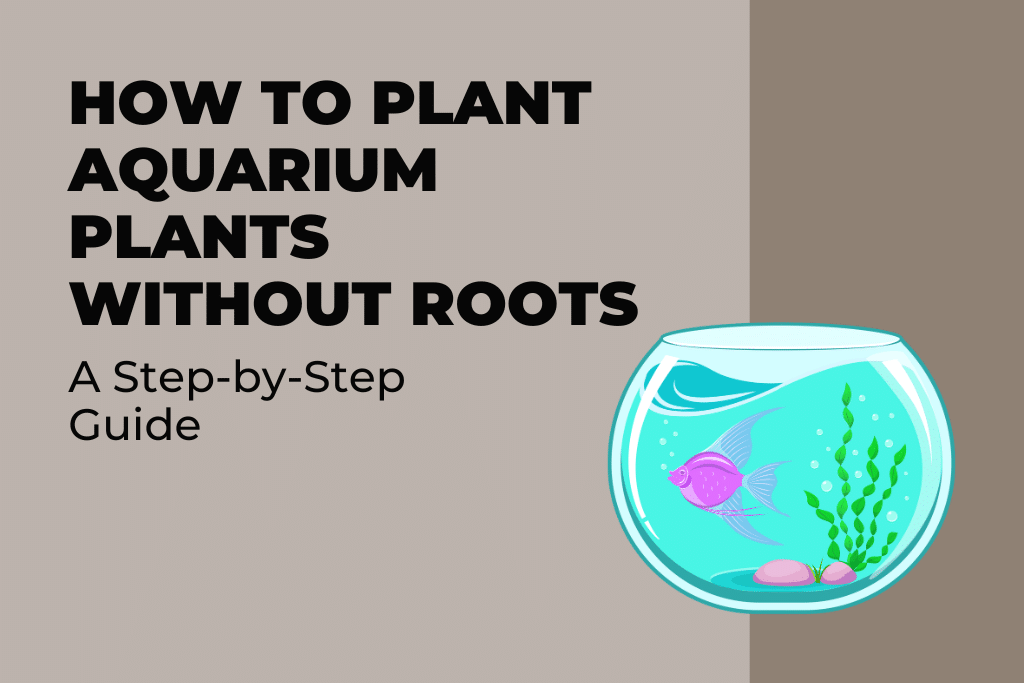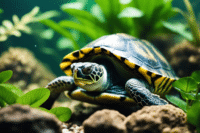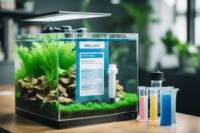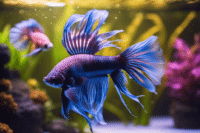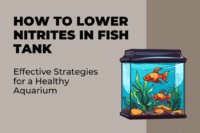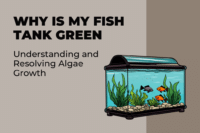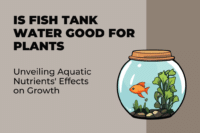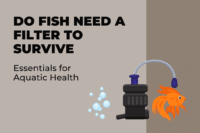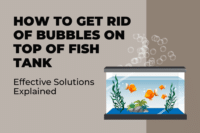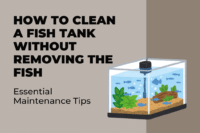Aquarium enthusiasts often seek to enhance their aquatic environments by introducing plants into their tanks. Planting aquarium plants without roots might seem like a daunting task, but it’s quite achievable with the right approach and materials. These types of plants are known to offer both aesthetic appeal and environmental benefits, serving as natural filtration and providing oxygen to the tank inhabitants. To successfully plant them, hobbyists are not limited to rooted options as many species of aquarium plants can thrive without the need for burying roots in substrate
Floating plants and those that can attach to decorations or the walls of the aquarium open up new possibilities for aquascaping. Species such as Anubias or Java Fern can be secured using thread or specialized glue, and will eventually adhere to the surface they are attached to. In tanks without substrate, or those that prefer a minimalistic design, floating plants like Water Lettuce or hornwort can be used. These plants do not require anchoring, as they draw their nutrients directly from the water, creating a dynamic surface layer that moves with the currents. As with any aspect of aquarium keeping, understanding the needs of the plants and their role within the ecosystem is crucial for maintaining a balanced and thriving environment.
Key Takeaways
- A variety of aquarium plants can flourish without traditional rooting.
- Aquatic plants contribute to a balanced ecosystem and offer aesthetic value.
- Floating and attachable plants provide flexible options for aquascapes.
Selecting Suitable Species
When setting up an aquarium without rooted plants, one must carefully select species that thrive when floating or attached to decorations. These plants provide aesthetics and essential functions within the aquatic ecosystem.
Floating Plants and Their Placement
Floating plants are excellent for aquariums without rooted flora as they absorb nutrients directly from the water. Water lettuce and duckweed are low maintenance options that offer surface cover, reducing light and inhibiting algae growth. Amazon frogbit has roots that hang in the water, which can provide an interesting visual effect and additional filtration. Position floating plants away from filter outlets to prevent disruption of their natural floating behavior.
Choosing Rhizome Plants
Anubias and java fern are popular rhizome plants that attach to rocks, driftwood, or aquarium decorations. They don’t need substrate, the rhizome should be above the substrate level to prevent rot. Secure these plants with fishing line or cotton thread until their roots naturally adhere to the attachment site. For healthy growth, they require moderate lighting and can benefit from liquid fertilizers.
Stem Plants and Their Care
Stem plants, such as elodea, green cabomba, and water wisteria, can be planted without roots by anchoring their stems to an object or lightly burying them in substrate so they stand upright. They rapidly absorb nutrients from the water column and need regular pruning. Brazilian pennywort can be grown floating or anchored, thriving in varied conditions with bright indirect lighting. Ensure these plants receive proper nutrients and CO2 for optimal health and growth.
Preparing the Aquarium
Before introducing plants without roots to an aquarium, it is crucial to set up a suitable environment. The substrate and hardscape create the foundation, while maintaining optimal water parameters ensures a healthy habitat for plant establishment and growth.
Setting Up Substrate and Hardscape
Choosing the correct substrate is pivotal as it supports future plant growth. A nutrient-rich substrate helps rootless plants latch on until they can anchor themselves. It typically includes finely granulated materials that allow for easy attachment. For hardscape elements like driftwood or rocks, position them in a way that promotes stability and aesthetics—driftwood can serve as a planting surface for mosses and ferns. Layer the substrate evenly and rinse it thoroughly prior to placement to reduce cloudiness.
- Substrate selection:
- Nutrient-rich: Essential for plant nutrition.
- Fine granularity: Allows for easier attachment of plants.
- Hardscape placement:
- Position driftwood and rocks to offer planting surfaces and enhance stability.
Water Parameters and Quality
Maintaining proper water parameters is non-negotiable for sustaining plant life. This encompasses a balanced pH, hardness, and temperature that suit the specific needs of the chosen flora. Use a reliable testing kit to monitor these parameters closely. Ensure the water quality is high by using a filtration system that can remove harmful substances while preserving beneficial nutrients. Performing regular water changes can also assist in maintaining optimal conditions for plant growth.
- Water parameter checklist:
- pH level
- Hardness (GH and KH)
- Temperature
- Maintain water quality through:
- Efficient filtration.
- Regular water changes.
Planting Techniques
In this section, we will explore how enthusiasts can successfully incorporate plants into their aquariums even when those plants lack traditional root systems. Focus on secure placement and ongoing care is paramount for the health and aesthetics of the aquarium.
Anchoring Plants without Roots
For plants such as Anubias which typically possess a rhizome rather than true roots, anchoring is a crucial step. These plants must be attached to a stable surface like a rock or a piece of driftwood. To do this, one can use fishing line, cotton thread, or even specialty plant glue to secure the rhizome firmly. Over time, the Anubias will naturally adhere to the surface as it grows. It is important to ensure that the rhizome—the horizontal stem from which leaves grow—is not buried, as this can cause rot.
- Tools for anchoring:
- Fishing line
- Cotton thread
- Plant glue
Tip: Place these anchored plants in the middle or background to create depth and cover bare bottom areas of the tank, mimicking their natural habitat.
Caring for Rootless Floating Species
Floating plants like java moss and other free-floating species draw nutrients directly from the water column, making them ideal for tanks without a substrate layer. Care for these plants entails managing light conditions and keeping water parameters within ideal ranges. Too much light can promote algae growth, which competes with the floating plants for nutrients.
- Maintenance checklist for floating plants:
- Ensure adequate light, but not excessive, to prevent algae.
- Regularly fertilize to replenish nutrients in the water column.
It’s important to monitor the growth of floating species since they can quickly cover the surface of the water, blocking light and oxygen exchange for other inhabitants. Trim as necessary to maintain balance within the aquarium ecosystem.
Maintenance and Growth Optimization
Maintaining aquarium plants without roots involves careful management of water conditions and plant health to optimize growth. This management primarily includes trimming and propagation to encourage healthy growth, and controlled fertilization to provide essential nutrients.
Trimming and Propagation
Regular trimming is crucial for maintaining plant health and aesthetics. Heavily trimmed plants can result in denser growth, while also potentially reducing the incidence of algae as there are fewer old leaves for algae to anchor. Propagation varies by species; however, most stem plants can be propagated by cutting the top portion and replanting it into the substrate.
Nutrients and Fertilization
Aquatic plants absorb nutrients directly from the water, making water quality and fertilization indispensable. Liquid fertilizers are beneficial for plants without roots, allowing them to receive nutrients like nitrogen, phosphates, and potassium. Iron is another essential nutrient that can promote vibrant, green leaf growth.
For optimal growth, CO2 injection may be used to boost plant vigor, particularly for demanding species. Tablets or root tabs can be of little use for rootless plants, making liquid plant food a more suitable choice. Essential water chemistry parameters – such as pH, carbon hardness (KH), and general hardness (GH) – should be maintained within the recommended range for the specific aquatic plants to prevent stunted growth.
Aquarium lighting should provide a full spectrum for photosynthesis, ensuring growth rates are stable. Some plants, particularly oxygenating plants, can thrive with moderate lighting; however, too much light without adequate CO2 can encourage algae growth.
In summary, a comprehensive approach to lighting, fertilizer usage, CO2 levels, and nutrient supply are critical for the successful maintenance and growth of aquarium plants without roots.
Common Issues and Solutions
Planting aquarium plants without roots can lead to specific challenges that aquarium enthusiasts encounter. Addressing these challenges effectively is crucial for maintaining a healthy and visually appealing aquascape.
Combatting Algae and Maintaining Clear Water
Algae Overgrowth: A common issue in aquascaping, especially for beginners, is the battle against algae. Algae thrive when there is an abundance of nutrients and light. To combat algae, one can manage light exposure and employ algae-eating aquatic creatures.
- Lighting: Reduce lighting to 6-8 hours per day.
- Nutrient Control: Regular water changes, at least 25-30% per week, help to control excess nutrients.
Water Quality Management: Maintaining high water quality is critical for plants without roots. They rely on the water column for nutrients, and poor water quality can hinder their growth.
- Regular Testing: Use water testing kits to monitor nitrate and phosphate levels.
- Filtration: Efficient filtration systems are crucial to maintaining good water quality and clarity.
Dealing with Plant Diseases and Pests
Plant Diseases: Diseases can manifest as discolored leaves or rotting stems. It’s important to promptly remove affected parts to prevent the spread.
- Isolation: Quarantine new plants before adding them to the main tank to prevent disease introduction.
- Hygiene: Sterilize tools after handling diseased plants.
Pests: Unwanted pests like snails or aquatic insects can hitchhike on new plants. These pests can damage your plants and disrupt the tank’s balance.
- Dipping Plants: A mild bleach solution or specialized pest dip can eliminate pests from new plants before introducing them to the aquarium.
- Manual Removal: Regular inspections and manual removal of pests can help keep their population in check.
While planting aquarium plants without roots presents unique challenges, these solutions will aid in creating a thriving environment for both the plants and aquatic life.
